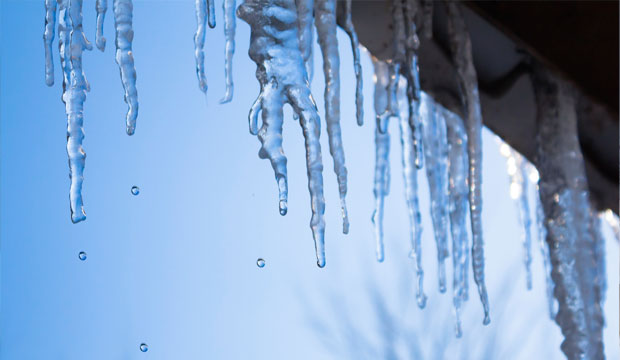
Those icicles hanging from your roof look pretty you say? Maybe so, but there’s really nothing good about buildups of ice on the edge of your roof. Not only are dangling icicles dangerous, but the buildup of ice and melted snow along the roof’s edge could mean damage to your roof, insulation, walls and ceilings. Repairs can be costly, so here is a break down of how they occur and what you can do to prevent them.
How are Ice Dams Formed?
While the rest of your home should be warm and cozy, a safe roof is one that is as cold as the outdoor air temperature. Outdoor temperatures below freezing and roof surface temperatures above freezing are a recipe for disaster – especially when snow begins to accumulate.
When the surface of the roof is too warm, it will start to melt any accumulated snow. The water will then trickle down the roof until it reaches the edge of the roof where temperatures are lower. The water then refreezes to form a dam. It doesn’t stop here, however. As the water continues to trickle down the roof, it will eventually start backing up under the shingles. Now you have a complete disaster on your hands.
Damaging Dams
Once water starts backing up under the shingles, it can leak into the attic and along exterior walls. This type of damage is particularly troublesome because it’s not always easy to see that it is happening until it is too late.
First, you may not be able to see an ice dam forming in the first place – especially if there is a heavy layer of snow on the roof. The snow will only melt along the surface of the roof without disturbing the top layer of snow so you may not even realize what is happening.
When water does start leaking into your home, it will trickle slowly and into spaces that you don’t regularly visit. Insulation in the attic can become wet and less effective, compounding the problem. Moisture can also accumulate throughout the winter and create the right environment for mold to grow when temperatures rise again.
How to Prevent Ice Dams
The key to preventing ice dams is keeping the surface of the roof cold. So why do some roofs become warm? Here are the usual suspects:
- Not enough insulation. This is the most common reason for a warm roof, and probably a chilly home. Instead of keeping heat down in the living areas where it belongs, an attic without enough insulation along the floor will let heat escape up to the roof.
- Poor ventilation. Along with keeping the heat out of the attic, you want to make sure enough cold air gets in, too. A properly ventilated attic will allow cold air to circulate from the bottom of the roof at the eaves up to the ridge of the roof.
- Heat sources in the attic. Eliminating all sources of heat in the attic is critical. Heat sources can include uninsulated recessed lighting, attic access panels and fold-up stairs, heating ducts, heating equipment in the attic, and improperly installed bathroom and kitchen vents.
- Clear your Gutters. Once all those leaves and pine needles have fallen off the trees, make sure you clean out your gutters. This will allow the melting snow to drain off the roof and not into your attic.
Don’t Delay
It’s never too late to get your home ready for winter. To learn more about adding insulation or other ways to keep your roof cold in the winter, contact the experts at Wattson Home Solutions today.






